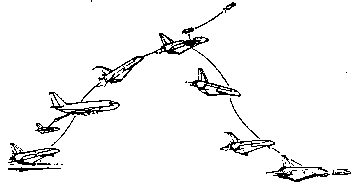
Figure 1: Aerial propellant transfer (APT) spaceplane flight plan. Because the aircraft takes off light, the mass of wings and landing gear is greatly reduced.

[W3 Ed note: This article originally appeared in the June 1995 issue of Analog Magazine. Since this version was entered by OCR software, some typographical errors may have been introduced. Figures and tables have been moved slightly relative to the text. (reprinted with permission of author) -DRR]
Since the dawn of the space age, building a vehicle that can fly to orbit using only a single stage has been the holy grail of astronautics. The problem is that single stage to orbit flight is really hard to do because the velocity change necessary to achieve orbit ("Delta-v," 31,000 ft/sec, typically), including losses due to aerodynamic drag, gravity, back pressure on the engines, steering, and so forth, imposes vehicle-full to vehicle-empty mass ratios that are difficult to achieve with current structural technology. The usual approach is to seek more energetic propellants with high specific impulse ("Isp" the number of seconds a pound of fuel can be made to deliver a pound of thrust) values. Alternatively, people have tried airbreathing approaches, which are also an attempt to achieve large Isp. The first approach, ultra-high Isp rocket engines, tends to involve propellants that are not very dense and are difficult to handle, such as liquid hydrogen. The second way, using hypersonic airbreathing jets, imposes surpassingly difficult design and operations problems such as those that have afflicted the National Aerospace Plane program.
Three major configurations have been proposed for single stage rocket vehicles: vertical take takeoff/horizontal landing (VTO/HL), such as the SSTO/R vehicle proposed by the NASA Access to Space Study; vertical takeoff/vertical landing (VTO/VL), such as the McDonnell Douglas Delta Clipper; and horizontal takeoff/horizontal landing (HTO/HL), such as the Boeing Reusable Aerospace Vehicle (RASV) or British HOTOL designs. Between the first two of these, there is no obvious distinction in terms of empty weight. Credible design studies appear to give similar weight estimates for similar vehicles. Horizontal takeoff and landing vehicles, however, tend to be much heavier for a given payload because of the unique requirements imposed by runway takeoff, with wing loads at rotation and the weight of landing gear being of particular concern. Because of these inert mass hits, horizontal takeoff and landing vehicle designs generally tend not to be pure single stage to orbit, but rely instead on sled launch or auxiliary boosters to reduce gross weight.

Figure 1: Aerial propellant transfer (APT) spaceplane flight
plan. Because the aircraft takes off light, the mass of wings and
landing gear is greatly reduced.
Our purpose is this article is to discuss another approach for operating spaceplanes off conventional runaways with conventional facilities: Using in-flight propellant transfer to reduce the takeoff gross weight of a rocket-powered aircraft, and hence its size, weight, and cost. This is not an attempt to solve the single stage to orbit problem by means of increasing Isp, but by decreasing Delta-v. It turns out that if you begin the mission to space from tanker altitude and airspeed, the amount of propellant that must be expended overcoming drag and gravity losses is greatly reduced, the vehicle tankage, wings and landing gear all become smaller, and everything becomes a whole lot easier.
The general concept of the operation of an aerial propellant transfer (APT) spaceplane is shown in Fig. 1. The spaceplane, carrying only a fraction of its required propellant, takes off a runway in a conventional manner using either rocket power or a set of air-breathing engines and climbs to rendezvous with a tanker, typically at an altitude between 20,000 and 40,000 ft., depending on the spaceplane design. The tanker transfers the remainder of the required propellant and departs, after which the spaceplane fires its main rocket engines at full throttle and accelerates to low Earth orbit. Upon reaching orbit, the payload is released, possibly to be propelled to higher orbit by its own propulsion system, while the spaceplane re-enters the atmosphere, glides to the vicinity of an airport, and then lands in either an unpowered or rocket or jet powered mode.
There are many variants possible to this basic plan, including selection of propellants, propulsion systems, and refueling scheme. For example, the possibility of a spaceplane using the leverage offered by employing very high specific impulse air-breathing propulsion above the tanker's maximum velocity of Mach 0.85 to cut the rocket's required Delta-v to orbit, needs to be considered and traded against the large inert mass penalties and System complexity associated with such jet engines. Use of smaller jet engines for takeoff, loiter, self-ferry and landing offer many operational advantages, but decrease performance.
In the case of refueling scheme, in principle both fuel and oxidizer could be transferred from the tanker to the spaceplane. However, for the propellant combinations of interest, between 72% and 88% of the vehicle's propellant is oxidizer, and therefore the lion's share of the benefit of aerial propellant transfer can be achieved by transferring oxidizer alone, with all fuel loaded on the ground. As such a scheme offers significant gains in simplicity and moderates the amount that the aircraft weight multiplies during refueling at a small cost in system performance, it was the method of choice for all systems included in this article.
It is useful to compare the general characteristics of the APT spaceplane to the three SSTO types that have been considered in the past. These are the Vertical Takeoff/Vertical Lander (VTO/VL), the Vertical Takeoff/Horizontal Lander (VTO/HL), and the Horizontal Takeoff/Horizontal Lander (HTO/HL). A summary of all four options is given in Table 1.
Table 1. Comparison of SSTO Options Concept VTO/VL VTO/HL HTO/HL APT Airframe Minimal Small Large Small Landing Gear Small Small Large Small Engines Large Large Medium Small Expans Varies 1 bar 1 bar 1 bar 0.2 bar New Infrastruct. Much Much Little Little Payload Medium Small None Medium P/L Integration Hard Hard Easy Easy Pad Site Flex Low Low High High Inclination Flex Low Low High High Abort Capability Low Low High High Self Ferry Maybe No Yes Yes Crossrange Low Medium Medium High Evolve w/ Jets? No No Yes Yes Launch Vehicle? Yes Yes No Yes Military A/C? No No Yes Yes Passenger A/C? No No Yes Yes Overall, the Aerial Propellant Transfer (APT) Vehicle Rates the Highest.
The airframe of the VTO/VL is clearly the lightest, but the VTO/HL is not far behind, and because it takes off and lands light, the airframe of the APT spaceplane will be comparable to that of the VTO/HL. The large airframe required by the HTO/HL to take off at runway speeds with a full load of propellant severely penalizes this option by SSTO application.
In the case of landing gear, the VTO/HL and APT pull about even with the VTO/VL, but once again the HTO/HL system is severely penalized due to the excessive weight its gear must support.
In the case of engines, the APT spaceplane is a clear winner. This is because as a horizontal takeoff System, it only needs a system T/W (thrust/weight) ratio of about 0.8, while the vertical takeoff VTO/VL and VTO/HL needs T/W ratios closer to 1.5, effectively doubling their engine mass requirement relative to the APT spaceplane. The HTO/HL will also need larger engines than the APT because it is carrying inert mass penalties in its airframe and landing gear, and because its required Delta-v to reach orbit is greater. Furthermore, the VTO/VL, VTO/HL, and HTO/HL rocket engines all must be designed to expand their exhaust gasses to a sea level environmental pressure, while the APT spaceplane rocket engine need only face a maximum back pressure of the air at tanker altitude, which can be as little as 0.2 bar. This makes it much easier to achieve optimal rocket engine performance on the APT spaceplane system.
The vertical takeoff options require a lot of expensive new infrastructure in the way of launch pads, while the HTO/HL and APT spaceplane, which use existing airports, require little or none.
The vertical takeoff systems' payload integration is much more complex, and pad site flexibility, payload orbit inclination flexibility, and abort capability are much more limited than either the HTO/HL or APT options. The vertical takeoff systems require specialized pads, the HTO/HL and APT systems can take off and land at conventional airports anywhere in the world, and can ferry themselves around the world for payload integration, launch operation, or vehicle servicing, as required. The winged options have much greater cross-range capability upon reentry than the VTO/VL, with the APT spaceplane having the most, since compared to the VTO/HL or HTO/HL it has the fewest conflicting requirements with the demands to optimize the airframe and trajectory for effficient hypersonic flight. If hypersonic air-breathing propulsion systems should become available, the HTO/ HL and APT can evolve to take advantage of them, while the vertical takeoff systems cannot.
As a launch vehicle the VTO/VL and APT have the highest payload capability, the VTO/HL less, and the HTO/HL none. On the other hand, the APT and the HTO/HL have the potential of functioning as a revolutionary military or civil aircraft while the vertical takeoff systems cannot. Thus, of the four options considered, only the APT has the potential of functioning effectively both as a launch vehicle and as a revolutionary ultra-high speed aircraft, and can therefore be rated as having the highest potential overall.
We've looked at four candidate propellant combinations for use in an APT vehicle; LH2/LOX, CH4/O2, RP/O2, and JP-5/H2O2. All of these are non-toxic and non-polluting.
LH2/LOX offers the highest specific impulse (450 s) of any realistic chemical propellant option. It also offers a relatively high oxidizer/ fuel mass ratio (6:1) which is advantageous in an APT spaceplane system, and several off the shelf engines are available. The primary disadvantage of LH2/LOX is the very low density of hydrogen, which creates the need for large volume tanks which are difficult to incorporate into a reasonable airframe design, and which also creates tankage mass penalties that counter much of the benefit of LH2/LOX's high Isp. An additional disadvantage is the necessity to handle the very cryogenic hydrogen, which stores at 20 K, and is not available to support vehicle operations in many parts of the world.
CH4/O2 offers the second highest Isp (385 s), with the benefit of a great increase in propellant density over LH2/LOX (CH4 is seven times as dense as hydrogen), allowing tankage sizes and masses to be brought under control. The O2/CH4 mixture ratio of 3.5:1 is not too bad, and while both CH4 and O2 are moderately cryogenic, they both store at the same temperature (around 90 K) so that compact tankage arrangements are possible. Liquid methane, while not a staple at today's airports, is available in most places around the world. In fact, CH4/O2 is by far the cheapest rocket propellant combination there is, so that if APT spaceplane operations were to expand to the point where fuel costs were an important factor, this would be a real plus. A significant disadvantage of CH4/O2 is that no flight-rated engine is currently available; development of one based on Pratt and Whitney RL-10 engine technology would probably take three years and cost on the order of $30 million.1
RP/02 (RP is rocket engine grade kerosene) offers a specific impulse of 355 s (using Russian NK-31 engines), and a rather dense propellant combination, only one of whose members is cryogenic. Existing engines achieve their highest specific impulses at mixture ratios of about 2.6:1, which is on the low side from the APT point of view, but the fact that such engines are available off-the-shelf could make RP/02 the propellant choice for a near-term APT system.
JP-5/H2O2 only offers an Isp of about 330 s, but it is by far the densest of the four propellant combinations considered (H2O2 is 1.43 times as dense as water), and burns with a mixture ratio of 7.3:1, very satisfactory from the APT point of view. JP-5 (ordinary jet fuel) is cheap and available at airports everywhere; H2O2 is ten times as expensive as LOX but still a lot cheaper than N204, and is available in many parts of the world. The big advantage of the JP-5/H2O2 propellant combination is that it is entirely noncryogenic, so that the required tanker modifications needed to support APT operations will be much less involved than for the other propellant combinations considered. A significant disadvantage of the JP-5/H2O2 combination is that no high-performance engine utilizing it is currently available. Modifying a Russian NK-31 might produce a rocket engine with an Isp of 330 s and a T/W of 60 at a program cost of about $25 million 2. Developing a clean sheet engine to improve the T/W above 60 could cost significantly more.
We conducted a trade study to examine the performance of these four propellant combinations across a range of APT options and compared them against a VTO/HL baseline. The VTO/HL assumed in our study has no jet engines and must perform a 31.1 kft/s Delta-v to reach orbit from a launch pad. The VTO/HL has a pad liftoff T/W of 1.5. The three APT spaceplane options included:
The "Mach 0.8" option, in which small turbofans are employed to bring the APT fully loaded with fuel (but no oxidizer) up to rendezvous with the tanker. As the APT is loaded with oxidizer during refueling, the increased thrust required to maintain flight is provided by placing a towing load on the refueling boom. After separation the rocket engines are lit and provide the full 27.9 kft/s required to bring the APT spaceplane to orbit from the tanker's Mach 0.8, 20,000 ft level flight condition. The Mach 0.8 APT has a T/W of 1.0 at rocket ignition.
The "Mach 3.0" option, in which larger jet engines are employed that not only can maintain the APT on the tanker until fully fueled but also accelerate the APT spaceplane up to Mach 3.0, prior to ignition of the rocket engines. This reduces the required rocket Delta-v to orbit to 24.0 kft/s. The Mach 3.0 APT spaceplane has a T/W of 0.8 at rocket engine ignition.
The "Mach 5.5" option in which subsonic combustion ramjets are employed to bring the APT up to Mach 5.5 prior to rocket ignition. This reduces the required rocket Delta-v to orbit to 20.7 kft/s. The Mach 5.5 APT has a T/W of 0.6 at rocket engine ignition.
We assumed that the subsonic L/D (Lift/drag) for APT vehicles was equal to 10, supersonic L/D was set equal to 3. Rocket engines were assumed to have a T/W of 60, jet engines a T/W of 8. Tanks were assumed to have a mass fraction of 4% of the propellant they contain if the propellant was water density; this fraction scaling inversely with the 2/3 power of propellant density.
The results of the analysis are shown in figs. 2, 3, 4, and 5. Fig. 2 shows the ratio of "payload" to vehicle wet mass for the options considered. "Payload" here is defined as that portion of the vehicle dry mass not consumed by tanks, wings, landing gear, rocket or jet engines. You can see that under the VTO/HL mode, only the high- performing LH2/LOX and CH4/02 propellants can deliver any payload at all to orbit. On the other hand, if the APT mode is employed, all of the propellants analyzed can be used to achieve SSTO operation.
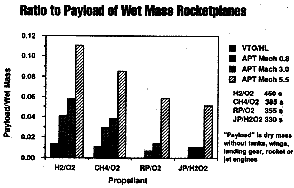
Figure 2: Ratio of payload to wet mass pf rocketplanes. It
can be seen that for any propellant chosen all of the APT options
outperform a VTO/HL.
The ratios of payload to wet mass in Fig. 2 appear to indicate large advantages for the higher performing propellants, however a more relevant basis of comparison is the ratio of payload to day mass, and this is shown in Fig. 3. Here you can see that CH4/O2 offers equal performance to the operationailly much more cumbersome LH2/LOX, and that both of these propellants more than double their payload when used in APT mode compared to their VTO/HL utilization. You can also see that RP/O2 and JP-5/H2O2 offer about equal performance, with JP-5/ H2O2 holding a slight edge for the Mach 0.8 (more or less pure rocketplane) incarnation. Interestingly, the data also shows that using airbreathing propulsion to go to Mach 3 offers little benefit over lighting the rocket engine in the subsonic. However if the airbreathers can be used to drive the APT up to Mach 5.5 (the upper limit of subsonic combustion ramjet operation), they more than pay for their mass penalty with reduced rocket Delta-v, and the payload gains start to become impressive. Since the lower performing RP/O2 and JP-5/ H2O2 propellants are hurt more by having to deal with a large Delta-v, they benefit more by airbreathing augmentation; in the Mach 5.5 APT their payload delivery comes close to matching the CH4/O2 and LH2/LOX options.
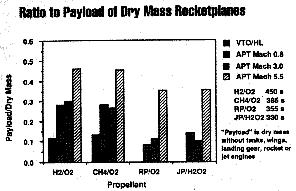
Figure 3: Ratio of payload to dry mass of rocketplanes. An APT
spaceplane using JP-5/H2O2, firing its rocket engines from Mach 0.8
outperforms a LH2/LOX VTO/HL taking off from the ground.
Dry mass allocations for the Mach 0.8 and Mach 5.5 APT systems are shown in Figs. 4 and 5. Both tankage and rocket engine masses drop sharply as we go from the Mach 0.8 to the Mach 5.5 versions, and while jet engine mass greatly increases there is still a net gain in payload. Interestingly, the tankage mass of the JP-5/H2O2 system is slightly less than the LH2/LOX system; it's carrying much more propellant but the propellant is much denser, resulting in rough equality. It should be noted, however, that no mass penalty was assumed in this analysis for insulating the hard cryogenic hydrogen, nor was any vehicle L/D penalty assumed for the non-optimal airframe shape that hydrogen use may require. If these effects are taken into account, hydrogen's performance evaluation could turn out to be much less favorable.
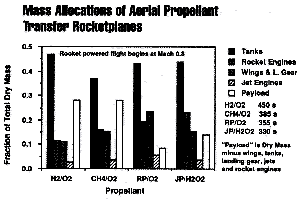
Figure 4: Dry mass allocations of Mach 0.8 takeoff rocketplanes.
Tankage mass dominates the system.
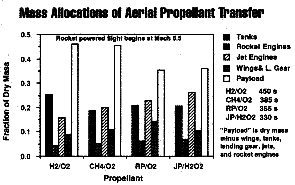
Figure 5: Dry mass allocations of Mach 5.5 takeoff rocketplanes.
Payload delivery of all four propellant options are comparable.
Therefore, to summarize, what we've shown is that the APT mode offers large improvements in payload delivery over the VTO/HL mode, so much so that an APT using low-performing non-cryogenic JP-5/H2O2 actually outperforms a VTO/HL using cryogenic LH2/LOX (fig. 3). Within the APT family, the CH4/O2 system offers the highest performance, but if operational considerations such as the desire to avoid cryogens entirely or the need to employ off-the shelf engines in a near-term vehicle are taken into account, then JP-5/H2O2 or RP/02 both offer attractive options with real near-term capability.
During the winter of 1993-94, the U.S. Air Force's Phillips Laboratory conducted a contracted six-week study 3 with WJ Schafer Associates and Conceptual Research Corporation which developed the APT concept further. Since the emphasis was on maximizing the use of existing components and keeping the design simple, existing tankers, landing gear, and conventional technology were used as much as possible. For reasons which cannot be explained here, the rocketplane design was named "Black Horse."
The ground rules for the study were:
The first problem addressed in the study was how to do in-flight refueling of rocket propellants. In-flight refueling of jet aircraft is commonplace in the US Air Force and Navy today. Two systems are used: the Navy's probe and drogue system and the Air Force's boom refueling system. The probe and drogue system requires the pilot of the receiver aircraft to do all the work, and transfers about 250 gallons per minute. The boom system requires some cooperation between the boom operator and the receiver aircraft pilot, and can transfer 1,200 gallons per minute. The boom refueling system was selected for this design because of its high rate of propellant transfer. Two types of tankers use the boom system today: the KC-10 and KC-135. Of these, the KC-135 is smaller, less expensive, and more readily available. Of particular interest is the KC-135Q and KC-135T. These aircraft have an isolated fuel system, from which the tanker's own engines cannot draw. This will allow dedicated rocket propellant tankers to op erate with only minor impact on the tanker's own systems. To avoid a costly development program, and the need to completely re- engineer the transfer system, it was decided that the propellant carried by the tanker serving Black Horse should be noncryogenic and non-toxic.
There are only a few non-cryogenic oxidizers available: red fuming nitric acid, nitrogen tetroxide, and hydrogen peroxide are the obvious choices. Of these, only hydrogen peroxide is non-toxic. It has other advantages as well. It is very dense (1.432 g/cc in 98% concentration). It has a vapor pressure about one-ninth that of water. It is relatively inexpensive because it is an ordinary industrial chemical rather than a dedicated rocket propellant. Because it is a good coolant, ordinary JP-5 rather than expensive RP-1 can be used as the fuel. Although some special precautions must be taken to prevent it from decomposing in the presence of impurities, it is a stable molecule, and once those precautions have been taken it essentially handles like water. Detailed analysis of a hydrogen peroxide/jet fuel engine indicates the performance figures shown in Table 2 for a engine running with a mass mixture ratio of 7.30:1 (oxidizer fuel). The two columns in Table 2 are for the two versions of the engine. (Black Horse carries seven engines: two for take-off and five for climb.) The "takeoff" version is operable at sea level and permits the aircraft to take off, rendezvous with the tanker, and transfer propellant. The "climb" version is only operable at tanker altitude or above, and is optimized for the climb to space.
Table 2: JP-5/H2O2 Engine Performance
Climb Engine TakeoffEngine
Chamber pressure 3000 3000 psia
Exit plane pressure 1.0 5.7 psia
Expansion ratio 240 70 -
Ideal Isp (shifting equilibrium) 354 340 sec
Losses due to geometry 2.4 2.4 sec
Chemical Inefficiency Losses 1.8 1.0 sec
Viscous drag 7.8 6.6 sec
Energy release efficiency 6.7 7.3 sec
Delivered Isp (in vacuum) 335 323 sec
Thrust 19930 19210 lb
Weight 310 280 lb
The advantages of the Black Horse aerial propellant transfer concept are threefold. First, the propellants are at a very high density - 1.32 g/cc of propellant at the mixture ratio given. This leads to a smaller vehicle and the capability of transferring up to 155,000 pounds of hydrogen peroxide from the tanker to the receiver. Second, they are non-cryogenic, so that the modifications to the KC-135Q or KC-135T model tanker will be minimal. Finally, the mixture ratio is unusually high. At a mixture ratio of 7.30 to 1, 88% of the benefits of aerial propellant transfer is available if one propellant only is transferred. This helps with keeping the operation simple and removes some safety concerns with simultaneous propellant transfer.
The Black Horse mission profile begins with a takeoff from a conventional runway using the two takeoff rocket engines for thrust. The aircraft is loaded with all the fuel it needs for the climb from the tanker to orbit. It also has fuel and oxidizer aboard sufficient for 15 minutes of atmospheric flight. The total weight of the vehicle at takeoff is about 50,000 pounds, but by the time it achieves tanker rendezvous at 43,000 feet and 0.85 Mach number its weight has dropped to about 38,000 pounds. When the aircraft meets the tanker it takes on about 147,000 pounds of hydrogen peroxide. It then disconnects from the tanker and climbs to space. As it inserts into orbit, its weight has dropped to about 16,500 pounds. After performing its orbital mission, the aircraft reenters and then glides to a normal landing at a runway. A drawing of the Black Horse vehicle is shown in Fig. 6.
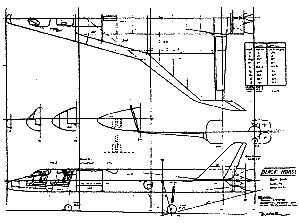
Figure 6: Black Horse, a single stage to orbit vehicle using aerial propellant
transfer.
With a wing span of 39.5 ft and a length of 57.5 ft, the aircraft is
comparable in size to a F-16 fighter. (Drawing by Dan Raymer)
The weight buildup of a rocketplane vehicle will determine whether it is possible to enclose the required volume of propellant in an aircraft that weighs little enough to permit that propellant to launch it into space. Table 3 indicates the assumptions for each of the major weight components and the total weight of the Black Horse system. The basic assumptions made for the vehicle were to apply conventional structurait technology by forming the blended wing/ body of the aircraft from ordinary aluminum alloy. The thermal protection system technology deemed suitable for this application is carbon/silica carbide for the nose cap, DuraTABI for broad areas on the lower surface, and a lightweight blanket insulation for the upper surface. The crew cabin accommodations are austere, as in the U2 reconnaissance aircraft.
Unlike most spaceplane designs, Black Horse needs to have a particularly high subsonic lift to drag ratio. This is necessary for two reasons. First, the requirement to fly in the atmosphere on the rocket engine impels the designer to minimize thrust required, so that the rocket propellant load at takeoff remains small. Second, the vehicle's gross weight changes by a factor of about 4.5 during propellant transfer. The maneuver will be very difficult for the pilot to fly if the aircraft does not have a good cruise lift-to-drag ratio. To accomplish these objectives, the Black Horse aircraft features a highly blended design to maximize volume. The doubledelta platform was adopted to provide minimal change of the aerodynamic center over a broad speed range, and also to provide a large strake to hold fuel and oxidizer so that the center of gravity does not move as the propellant is consumed.
Table 3. Black Horse Weight Breakdown (pounds) Structures Group 6,686 Wing 1,572 Vertical tail 739 Fuselage 2,924 Main landing gear 916 Nose landing gear 243 Engine mounts 292 Propulsion Group 3,091 Engines 2,120 Fuel system 971 Equipment Group 1,181 Flight controls 372 Instruments 142 Avionics 567 Furnishings 100 Mission-specific Group 4,000 Reaction controls 400 Life support 800 TPS 2,800 Total Empty Weight 14,958 Load Group 33,494 Payload 1,000 Crew 440 Propellant 32,054 Takeoff gross weight 48,452 Tanker rendezvous weight 37,380 Oxidizer transfer 146,870 Gross light-off weight 184,250
The overall wing area is 780 square feet. The wing loading is sufficiently low that no liift devices such as flaps or slats should be needed for takeoff or landing, especially with the enormous thrust available from the rocket engine The low wing loading also helps a lot in moderating the thermal environment during reentry.
Another study of a somewhat different APT concept was done at Martin Marietta during January through May 1994, this one of a near-term suborbital X-Plane that could serve as a demonstration vehicle for the APT concept. Because the vehicle was about half the size of Black Horse, it was decided to call it "Black Colt." A drawing of this vehicle is shown in Fig. 7.
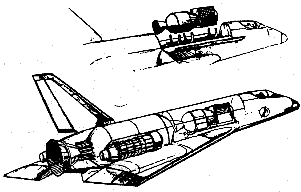
Figure 7: Black Colt flies on a suborbital trajectory to Mach 12 and
80 nautical mile altitude. The payload is then delivered to orbit by a
Star 48V solid rocket, after which orbit circulation is done by the
satellite's thrusters.
The spirit of Black Colt was to design something that can be buiit and flown today. Thus, an existing NK-31 RP/O2 rocket engine was chosen for primary propulsion, with two Garrett F 125 turbofans used for takeoff, loiter during aerial propellant transfer, and landing propulsion. Also, rather than push for the very high performance required to achieve true SSTO operation, it was decided to settle for only flying Black Colt to haif orbital velocity, with the 1000 lb payload then being delivered to orbit by means of a Star 48V upper stage. By adopting this strategy, it was found feasible to design a reusable satellite delivery system with a wet mass fraction of 0.78 which represents a large relaxation in requirements relative to the 0.92 needed for Black Horse. Since the expended Star 48V only costs $1.4 miillion and allows Black Colt to deliver a larger payload than a $12 million Pegasus, the trade was considered quite favorable. The Mach 12 reentry required of Black Colt is also much less demanding on the technology of reusable thermal protection systems than the Mach 25 reentry of any true SSTO.
The NK-31 burns oxygen and kerosene at a mixture ratio of 2.61. Thus about 19,000 lbs of kerosene are required to burn with the oxygen. The remaining 2,000 lbs are used for climb to the tanker and for 30 minutes of subsonic powered flight after reentry. When fully fueled with kerosene and carrying no LOX or payload, the vehicle has a fuel mass fraction of 0.53, with a subsonic L/D of 9, this gives it a subsonic seif-ferry cruise range of about 3,300 nautical miles.
While the Black Colt's F125 engines have a sea level static thrust of 10,000 lbs each, thrust falls off to 6,300 lbs each at 20,000 ft and Mach 0.8. Since the vehicle has a subsonic L/D of about 9, implying a total thrust requirement of 10,500 lb when fully loaded, this limits the refueling altitude to about 23,000 ft if the refueling is to be done under jet engine power alone.
Rather than modify the fuel tanks of a KC-135 to carry LOX, it was felt that the simplest way to enable aerial LOX transfer would be to carry a dedicated LOX tank within the fuselage of any suitable large subsonic aircraft. Tank trucks of the Liquid Air company currently carry tanks with 70,000 lb LOX capacity, greater than that required for Black Colt. Such tanks have boiloff rates of less than 0.25% per day, and with a diameter of less than 8 ft, could be installed within many candidate aircraft. This leaves a cryogenic refueling boom as the primary refueling related development item. While transferring LOX at altitude has been raised by some as a safety concern, in many respects such transfer is safer than handling LOX on the ground, as any LOX spills will be instantly dissipated to the environment and there is no water around to freeze things up.
A cost estimate was done on the Black Colt program. Current estimates indicate that such a vehicle could be up and flying within three years of program start for a total cost of less than $100 million.
Unlike most space vehicles, it will be possible to test the aircraft proposed here in a conventional flight test environment. No special range requirements beyond what is conventionally available at, for example, Edwards AFB should be required. Because there are aviators aboard the vehicle, no destruct package is needed. Aside from storage areas for the new propellant, it should not prove necessary to construct any new facilities for any phase of this program.
The flight test program could begin in a conventional build-up fashion, starting with taxi and ground tests, first flight, performance, and flying qualities testing. This phase of the program would emphasize handling qualities while connected to the tanker boom, because the oxidizer transfer could as much as quadruple the weight of the aircraft when it takes place. Once the flight control system has been qualified, transfer of steadily increasing amounts of oxidizer would support envelope expansion and flight to increased altitudes and airspeeds. Exoatmospheric flight and reentry could be investigated, and the operational envelope of the thermal protection system could be determined. The capability of the system to perform long distance ballistic transfers (in the case of Black Horse, to anywhere on Earth within one hour) could be demonstrated. Loading the aircraft with fuel and oxidizer, up to the maximum takeoff weight, could also permit exoatmospheric flight without propellant transfer. The ballistic ferry range of the Black Horse aircraft under these conditions is about 3,200 nautical miles, allowing for some aerodynamic range extension at the end of the trajectory.
Table 4: Black Colt Weight Breakdown (pounds) Turbojets (2 F125's installed, 10klbf each) 3,458 Rocket Engine (1 NK-31, 90 klbf) 1,540 Structure 3,200 Wings 2,490 Propellant Tanks 500 Landing Gear 1,621 Thermal Protection 1,760 Pressurization system 50 RCS 150 Avionics 450 Contingency (20%) 3,043 Total Dry Weight 18,263 Kerosene 21,000 Oxygen 50,000 Star 48V 4,840 Payload 1,000 Total Gross Weight 95,103
An orbital flight attempt would follow the envelope expansion phase. Investigation of on-orbit flying qualities could proceed at this point, as well as an experimental determination of reentry cross range. One sub-phase of the orbital flight test program of particular interest would be on orbit propellant transfer. If the aircraft were completely refueled in low-Earth orbit, it would have enough Delta-v to visit anywhere in cislunar space, such as geostationary orbits, or to perform multiple plane changes and visit many different points on a single mission. Reentry from increased altitudes and entry speeds could be tested, yielding an assessment of the capabiitity of a high temperature reentry capability in realistic conditions.
Beyond their application as SSTO payload delivery systems, there are many potential uses for Black Horse/ Black Colt type APT spaceplanes. With performance requirements considerably less than that needed for SSTO flight, such vehicles could fly from any point on Earth to any other point in less than an hour, with most of the flight being exoatmospheric. In the NASA arena, such APT vehicles flying routinely in a suborbital mode could be used as hypersonic test vehicles, medium duration (15 minutes per flight) zero gravity labs, ionospheric/thermospheric sounding vehicles, and even short duration astronomy platforms. Within the military sphere, APT vehicles could be used for a number of interesting applications, many of which are enhanced by the ability of an APT to bounce out of the atmosphere after an initial reentry. This would allow it to drop in over a designated area from space at hypersonic (Mach 10-20) velocities, release a payload, and then pop out of the atmosphere and get away to space (Fig. 8). Within the civil sector, such vehicles could be used for fast passenger transport, fast package delivery, prestige business travel, space barnstorming rides, and as a vacuum or zero gravity industrial research platform.
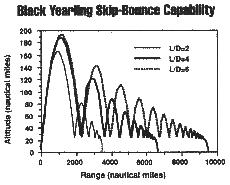
Figure 8: Atmospheric bounce capability of an enhanced Black Colt
("Black Yearling") aerial propellant transfer spaceplane. The vehicle
in question is propelled by two NK-31 rocket engines and two F404
turbofans. It has a dry mass of 22,000 lbs and carries 120,000 lbs of
propellant.
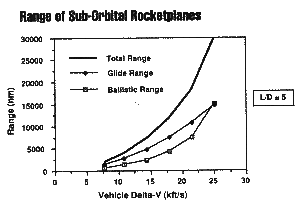
Figure 9: Ballistic and glide range capability of suborbital rocket planes.
It should be noted that most of the range of suborbital vehicles is provided by aerodynamic lift after reentry, not by the ballistic hop itself (Fig. 9). This is the fundamental reason why for all applications involving surface-to-surface distance capability, winged vehicles such as the APT offer much greater performance potential than strictly ballistic vehicles of the VTO/VL type. It can also be seen (Fig. 10) that the mass ratios required for such vehicles to achieve substantially global range for surface to surface travel on Earth are much less than those required for SSTO flight, which means that the payloads delivered can be much greater. It may be objected that while a CH4/02 APT might only require a mass ratio of four to travel from New York to Tokyo, which is clearly achievable in the engineering sense, a subsonic airliner can perform the same feat with a mass ratio of two, and thus despite its (much) faster flight time, the APT spaceplane would fail economically. This argument neglects the fact that almost 80% of the propellant of the CH4/02 spaceplane is LOX, which sells for $0.05/lb, compared to $0.20/lb for jet fuel. When the difference in the per pound price of propellant is taken into account, the spaceplane's fuel economy is quite competitive.
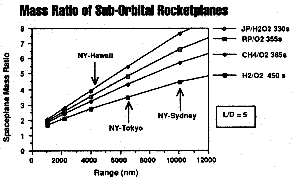
Figure 10: Mass ratio for suborbital rocketplanes utilizing various
propellants.
Beyond their baseline mode of operation, certain speculative operabonal modes exist that could signiticantly enhance the capability of APT vehicles in the future.
Consider the case where we have two Black Horse type vehicles, each using JP-5/H2O2 with an Isp of 335 s. The vehicles have a dry weight of 15,000 lb and a propellant load of 180,000 lb, which assuming a required Delta-v to orbit of 27 kft/s, allows them to deliver 1,000 lb to LEO. Now, let's say that we fly the two of them off together, accelerating them jointly not to orbit, but rather to a suborbital trajectory with a velocity of 18.5 kft/ s. The two space planes are now outside the atmosphere, in free fall (i.e. zero gravity) in the immediate vicinity of each other. Let's say we now bring the two together and extend a refueling boom, allowing the 20,000 lb of residual propellant from one to be transferred to the other. The two then separate, the empty vehicle to return to Earth, the enriched vehicle to ascend to orbit with a payload of 12,000 lbs. Without any new hardware, the orbital delivery capability of the system can be increased by a factor of 12.
Such a non-material enhancement by teamwork would allow even an APT spaceplane that was designed for suborbital flight to achieve orbit. Or put another way, let's say that it turned out after the construction was done that the actual Black Horse dry weight came in not at 15,000 lb, but at 24,000 lb, a 60% mass growth over the estimate. The vehicle would now only be capable of suborbital flight to 23 kft/s. However, if two such vehicles were flown, performed a suborbital propellant transfer at 15.5 kft/s, the enriched vehicle would be able to make orbit with a 1000 lb payload. Since the propellants being transferred are non cryogenic, such a suborbital zero-g propellant transfer could be done using bladders. If the APT in question used LOX for its oxidizer, the transfer would require a weak gravity field, which could be created by both vehicles firing their RCS systems continually during the transfer.
The plan certainly sounds incredible, and to be frank, we don't expect such maneuvers to be done anytime soon, but it's not impossible. On a suborbital trajectory with a velocity of 16 kft/s and a 120 nautical mile apogee, the vehicles in question will be out of Earth's atmosphere for about six minutes. The actual propellant transfer can be done in less than two minutes. With sufficient training, good pilots could eventually do the job.
The idea of refueling an airplane in flight must have seemed bizarre to anyone witnessing the Wright brothers first flights. By the 1920s it had been demonstrated, and today it is done routinely. Doing it on the way to space, and in space itself are just the next steps up the ladder.
What we've shown is that using inflight propellant transfer to reduce the Delta-v needed to fly to space makes it possible for a fighter sized aircraft to achieve orbit. Furthermore, such an aerial propellant transfer spaceplane outperforms alternative vertical and horizontal takeoff SSTO concepts, and offers a much greater range of potential alternative suborbital applications as well. If such a flight mode is used, a completely noncryogenic SSTO employing nontoxic rocket propulsion based on H2O2 and JP-5 is feasible, and even higher performing systems can be built using soft cryogenic CH4/O2 propulsion. Perhaps most importantly, the development of an aerial propellant transfer X-plane spaceplane could be done quickly and cheaply and would permit a variety of revolutionary military and civil capabilities to be demonstrated. Why most importantly? The answer is this:
If the real space age is ever going to be opened up, we will need to have a market for rocket vehicle technology that supports the manufacture of spacecraft components not in lots of ones or twos, but in hundreds or thousands or tens of thousands. If travel to orbit is ever to be as cheap as air travel, we will need a worldwide infrastructure that supports not hundreds of flights per year, but hundreds of flights per day. The only market that can support that kind of development is global long-distance surface to surface passenger travel - like it or not, a lot more people want to go to Tahiti than want to go to orbit. If you want to serve that market, you want to use winged rocketplanes, not vertical takeoff vehicles, because trillions of dollars worth of infrastructure is available all over the world - in the form of existing airports and surrounding facilities - to support their operation. Now it won't happen all at once, and for the same reason that military and then postal aircraft preceded passenger aircraft, military and fast package delivery rocketplanes will precede passenger rocketplanes. But once it does happen, once thousands of rocketplanes are crisscrossing the globe daily, serving business and vacation travelers from New York to Sydney, it won't be to hard to set some of them aside to establish passenger lines to orbit. In fact it won't be too hard to specially outfit a few to be refueled on orbit for expeditions to the Moon or Mars.
That's why Black Horse is an airplane worth fighting for.
The authors wish to acknowledge the important work done by Dan Raymer and the W. J. Schafer team of William Nurick, Frank Kirby, Ed Nielsen, Robert O'Leary, Rett Benedict, and Ray Waish in developing the Black Horse design concept. We also wish to acknowledge the contributions in helping to analyze the Black Colt performed by the Martin Marietta team of Sid Early, Jim Greenwood, Grady Romine, Robert Humphries, Greg Velasquez, Lars Onsager, Elizabeth Sholes, Ann Palen, and Jeff Schnackel. Useful comments and suggestions on Black Colt from Burt Rutan, of Scaled Composites and Lt. Col. Steve Brandt and Lt. Col. Doug Beason of the U.S. Air Force Academy are also gratefully acknowledged. The drawings shown in figs. 1 and 7 were done by Robert Murray, of Martin Marietta. The drawing of Black Horse shown in fig. 6 was done by Dan Raymer.